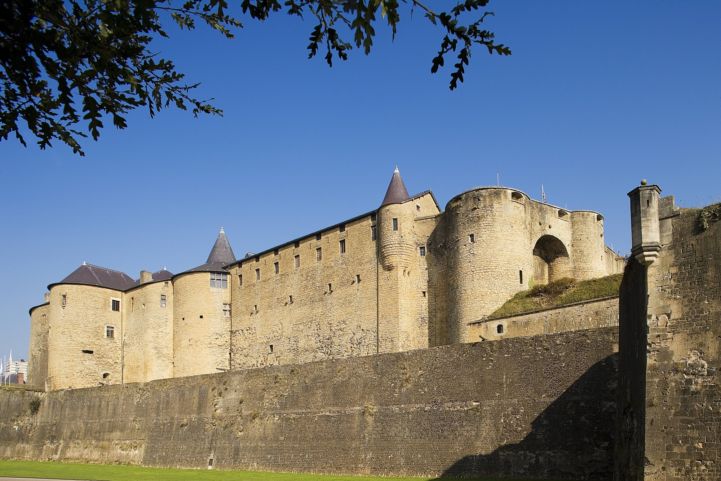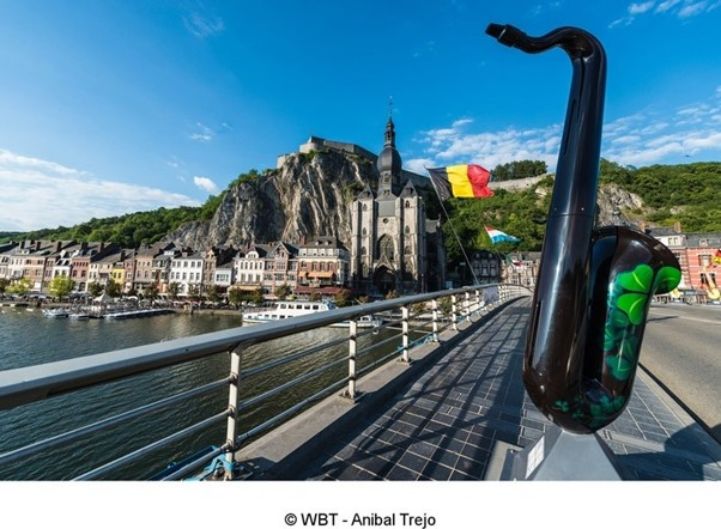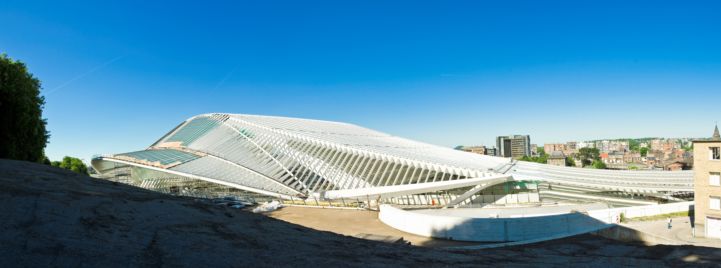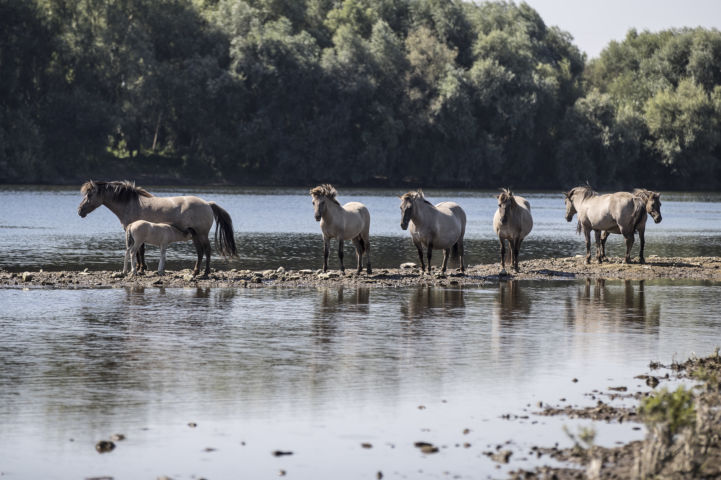Fifteen highlights to discover along EuroVelo 19 – Meuse Cycle Route!
Totalling 1050 km, the route is completely developed and signed with EuroVelo signs, and mainly flat as it follows the riverbanks. Being so well developed makes EuroVelo 19 – Meuse Cycle Route a perfect itinerary to explore for cyclists of all levels. In this article, we invite you to discover the route from your home via the main highlights along the way, selected by our partners in each country: Agence Régionale du Tourisme Grand-Est in France, Pro Velo in Belgium and Stichting Landelijk Fietsplatform in the Netherlands.
If you are planning to visit some of these highlights in the next few weeks however, please be aware that some places could be closed because of covid-19 restrictions. Just check the websites for the latest information.
France : Cycling from the source of the Meuse, through the foothills of the Vosges region and into the French Ardennes
The « ‘Faces of Jehanne’ » Centre in Domrémy-la-Pucelle
The village of Domrémy-la-Pucelle is well-known for being the birthplace of one of the most emblematic characters in French history: Joan of Arc. A visitors’ centre, created in 1999, presents the extraordinary journey of "the Maid of Orleans". In 2020, the centre was revamped and now provides a new journey through the life of Joan of Arc. To complete the experience, visitors are invited to discover Joan of Arc's Birth House, with several sculptures. More

The underground citadel
In Verdun, this immersive tour uses video and augmented reality to surround visitors with the history of the site and its 7 km of tunnels dug into the rock. You can walk in the shoes of the WWI soldiers experiencing their daily life in the Underground Citadel, as well as its battles, and participate in a medal ceremony. This brand-new 40-minute itinerary offers a unique way to discover this major remembrance site. More
The new Remilly-Aillicourt – Mouzon cycle route
In the French Ardennes, the greenway connecting Mouzon to Remilly-Aillicourt has been finished last year and is part of EuroVelo 19 – Meuse Cycle Route. This section follows agricultural management roads, which are not accessible to motorised vehicles, and makes a particularly charming part of the route. Cycle along the soft meanders of the Meuse, through pastures offering flowery landscapes!
The « Chooz Loop » cycle route
Just a little bit further on the route, the 7-km Chooz Loop cycle route was inaugurated last summer as part of the Ardennes Cyclo project. On EuroVelo 19, you can now cycle from Charleville-Mézières to Givet entirely on greenways. This new section, one of the steepest of the Meuse Cycle Route, is open to pedestrians, cyclists, horse riders and all non-motorised vehicles. On site, you can find the first charging point for electric bikes, a repair and washing station for bikes, a playground and a picnic area. More

The Fortified Castle of Sedan
The city-centre of Sedan is dominated by this nearly 600 year-old fortress. With an area of 35 000 m², it is Europe’s most expansive fortified castle from medieval times. If you are interested in history, make sure to plan a visit to this castle which still testifies to the role played by the former princes of Sedan on the French and European political scene. More
Belgium: Cycling among rocks and cliffs, through the economic capital of Wallonia and in the charming Belgian Limburg
The Waulsort Water Ferry in Hastière
As a first stop in Belgium, you can try out the manual water ferry in Hastière, which is a great experience especially for kids. As far back as the Middle Ages, the monks of the Waulsort Abbey installed a simple ferry to cross the river here, a little downstream from the present one, opposite the old abbey. By the beginning of the 19th century, there were about 10 of them in operation between the French border and Namur. The one in Waulsort is the last one in operation on the Meuse. More

Citadel of Dinant
In the beautiful Citadel of Dinant you can travel nine centuries into the past! The visit to the Citadel, built in 1815, traces its history from the sack of Dinant in 1466 all the way to the First World War, via the Louis XIV and Vauban periods. The fortress looks down on the Meuse Valley from its high cliff, offering one of the best views of the river! More
Citadel of Namur
Continuing your trip along the Meuse you will quickly reach Namur and its impressive Citadel overlooking the city, located on a hill at the confluence of the Sambre and the Meuse. This historic fortress is classified as being Exceptional Heritage of Wallonia. The Terra Nova Visitor Centre offers a journey back in time, a history of Namur and its Citadel through films, plan-relief models and documents. You can also discover 500 meters of the restored galleries in a guided tour that immerses you in the history of the Citadel. More
Brasserie C in Liège
What would a cycling journey in Belgium look like if it did not include the visit of a brewery? The Brasserie C, situated in the heart of Liège, at the foot of the Bueren stairs, would be a great choice. Their first beer, the Curtius, won the gold medal at the “Mondial de la Bière” and it is a local specialty not to miss. The brewery’s terraces, located at the bottom of the Citadel’s Coteaux, are also a real paradise; one of the best places to enjoy a beer in Liège! More

The Liège Guillemins train station
Built by the Spanish architect Santiago Calatrava Valls, this train station that reaches a height of 40 metres is an impressive piece of architectural art. With its enormous glass roof that lets the light in, it is often called a ‘cathedral of the modern age’. Although modern, the station bears in the ancient name of Guillemins, referring back to a religious order, the ‘Guillemites’. More
The Netherlands: Cycling through the dune landscapes of Northern Limburg, to the North Sea and reaching the international city of Rotterdam

Rivierpark Maasvallei
In the Maas Valley, between Maastricht and Maasbracht, people and nature are working together harmoniously to create a breathtaking landscape. For many years, man has tried to tame the river with dykes and dams, but this turned out to be counterproductive. After various floods, it was decided that the river would be given more space. It’s the largest Dutch river project in progress, covering a 43-kilometre long section. In 2025 the work should be completed. More
Maasheggen
The Maasheggen landscape consists of a mosaic of small meadows in the floodplains, bordered by braided fences mostly made up of hawthorn hedges. In the old days you could see the Maasheggen in many more places along the Maas in North Brabant and Limburg. Due to land consolidation, scaling up and the convenience of barbed wire, in many spots these hedges have disappeared. In 2018, UNESCO designated the Maasheggen as a biosphere area. As a result, the remaining Maasheggen are protected. More
Biesbosch
The Biesbosch National Park is listed as a protected nature reserve. The Biesbosch is partly used for agricultural purposes and there is also a lot of (water-based) recreation. Specially constructed storage basins are used to store clean surface water. Since 1994 the Biesbosch has been a national park, where now a lot of work is being done on giving more space to the rivers. More
Brielle
Brielle is one of the best-preserved fortified towns in the Netherlands. Definitely get off your bike here and soak in the atmosphere of this town. With over four hundred monuments there’s lots to see! Brielle played an important role in Dutch history: during the Eighty Years' War against the Spaniards, it was the first city to be liberated by the rebel ‘Watergeuzen’. More
World port city of Rotterdam
Rotterdam is home to Europe’s largest seaport, which ranks among the ten most important ports in the world. Including Maasvlakte 1 and 2, the port extends over a length of 40 kilometres. While cycling you will see many containers being transported over the water. In the port, the cargo is transferred from large seagoing ships to smaller inland vessels. The very dynamic city of Rotterdam offers more than this impressive port. Glittering skyscrapers, trendy restaurants and food markets, as well as numerous attractions and festivals. More
EuroVelo 19 – Meuse Cycle Route is currently being managed via a Long-Term Management Agreement (LTMA), aiming to sustain the transnational activities of the route. It was signed by the partners when the successful and well developed EuroVelo 19 - Meuse Cycle Route joined the EuroVelo network in March 2019. You can read more about EuroVelo 19’s LTMA on this page.